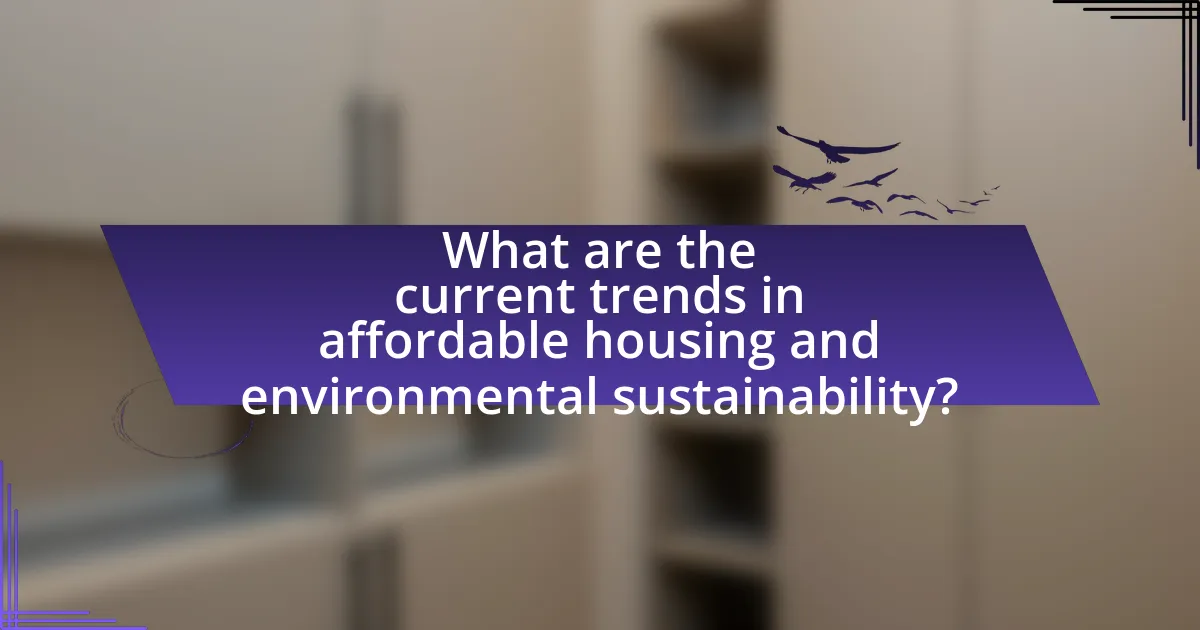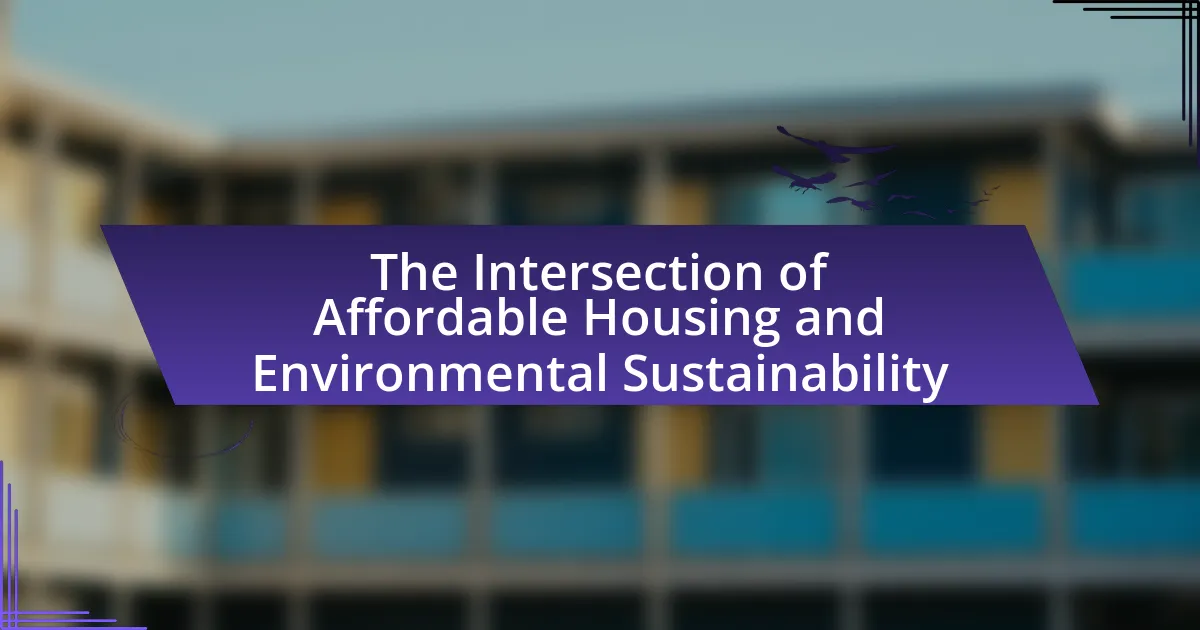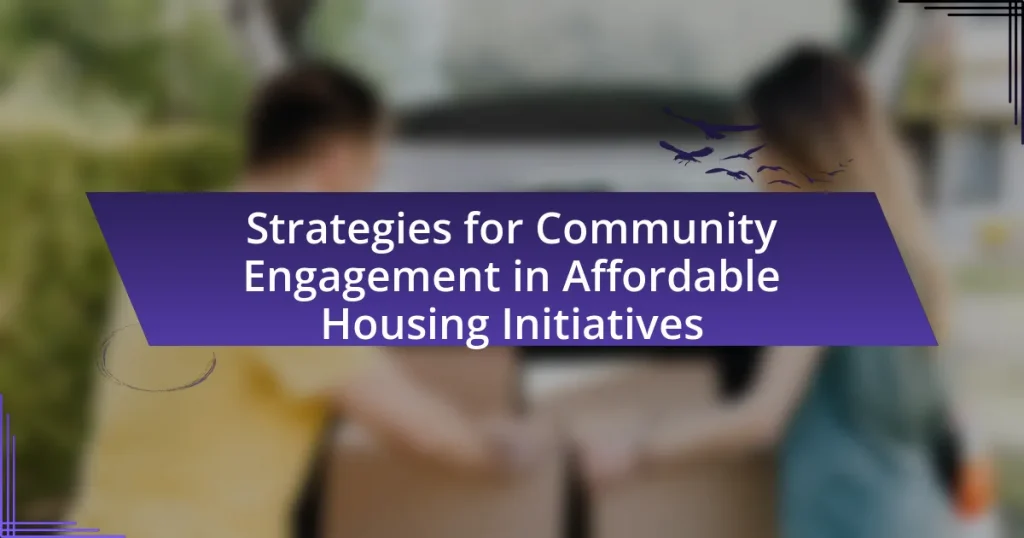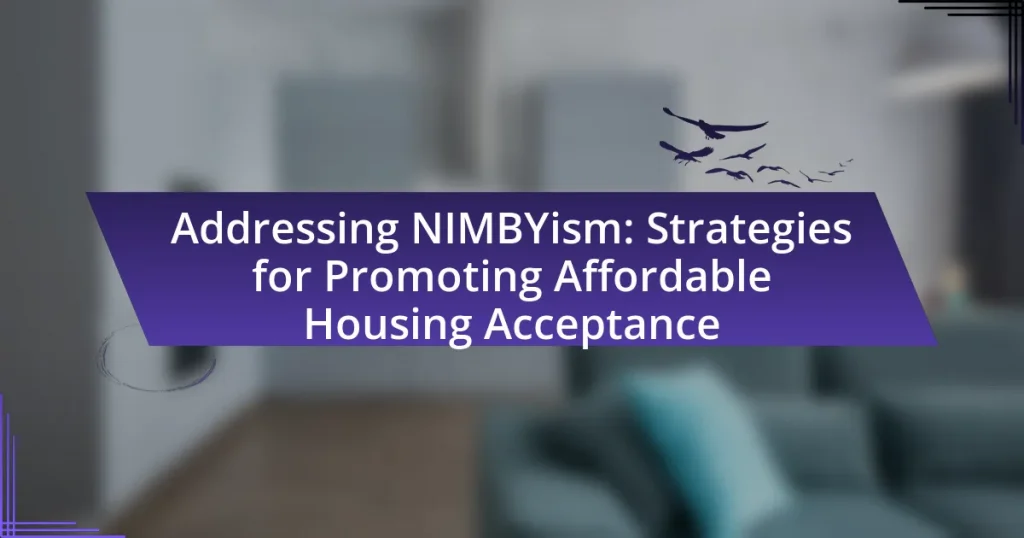The article examines the intersection of affordable housing and environmental sustainability, highlighting the integration of cost-effective housing solutions with eco-friendly practices. It discusses how affordable housing initiatives can incorporate sustainable building practices to reduce energy consumption and lower utility costs, ultimately benefiting low-income households. Key principles of affordable housing, such as accessibility and community integration, are explored alongside core concepts of environmental sustainability, including resource conservation and pollution reduction. The article also addresses current trends, challenges, and best practices in achieving sustainable affordable housing, emphasizing the importance of government policies and community engagement in fostering resilient and equitable living environments.

What is the Intersection of Affordable Housing and Environmental Sustainability?
The intersection of affordable housing and environmental sustainability lies in the integration of cost-effective housing solutions with eco-friendly practices. Affordable housing initiatives often prioritize low construction and maintenance costs, while environmental sustainability emphasizes resource efficiency, reduced carbon footprints, and the use of renewable materials. For instance, the U.S. Green Building Council reports that green building practices can reduce energy consumption by 30% to 50%, which not only lowers utility costs for residents but also contributes to environmental conservation. Additionally, sustainable housing designs, such as those incorporating energy-efficient appliances and sustainable materials, can enhance the affordability of living spaces by decreasing long-term expenses for occupants. This synergy promotes both social equity and environmental stewardship, making it essential for urban planning and policy development.
How do affordable housing and environmental sustainability relate to each other?
Affordable housing and environmental sustainability are interconnected as both aim to create livable, equitable communities while minimizing ecological impact. Affordable housing initiatives often incorporate sustainable building practices, such as energy-efficient designs and the use of renewable materials, which reduce carbon footprints and lower utility costs for residents. For instance, a study by the U.S. Green Building Council found that green building practices can lead to a 30% reduction in energy consumption, directly benefiting low-income households. Additionally, sustainable urban planning promotes the development of affordable housing near public transportation, reducing reliance on cars and further decreasing greenhouse gas emissions. This synergy between affordable housing and environmental sustainability fosters resilient communities that support both social equity and ecological health.
What are the key principles of affordable housing?
The key principles of affordable housing include accessibility, sustainability, and community integration. Accessibility ensures that housing is affordable to low- and moderate-income families, typically defined as spending no more than 30% of their income on housing costs. Sustainability focuses on creating energy-efficient homes that reduce utility costs and environmental impact, often incorporating green building practices. Community integration emphasizes the importance of affordable housing being located within existing neighborhoods, providing residents with access to essential services, transportation, and employment opportunities. These principles are supported by various studies, such as the National Low Income Housing Coalition’s report, which highlights the need for affordable housing to address economic disparities and promote social equity.
What are the core concepts of environmental sustainability?
The core concepts of environmental sustainability include conservation of resources, reduction of pollution, and promotion of biodiversity. Conservation of resources emphasizes the responsible use and management of natural resources to ensure their availability for future generations. For instance, the World Wildlife Fund reports that sustainable practices can help preserve ecosystems and maintain the balance of nature. Reduction of pollution focuses on minimizing waste and harmful emissions, which is crucial for protecting air and water quality; the United Nations Environment Programme highlights that cleaner production methods can significantly lower environmental impact. Lastly, promotion of biodiversity involves protecting various species and their habitats, as biodiversity is essential for ecosystem resilience and functionality, supported by research from the Convention on Biological Diversity, which states that healthy ecosystems provide vital services to humanity.
Why is the intersection of these two topics important?
The intersection of affordable housing and environmental sustainability is important because it addresses the dual challenges of providing accessible living options while minimizing ecological impact. Affordable housing initiatives often overlook sustainability, leading to increased energy consumption and environmental degradation. Conversely, sustainable practices can enhance the quality of affordable housing by reducing utility costs and improving residents’ health. For instance, incorporating energy-efficient designs in affordable housing can lower energy bills by up to 30%, making homes more affordable in the long run. This intersection fosters resilient communities that prioritize both economic and environmental well-being, ultimately contributing to a more sustainable future.
How does affordable housing impact environmental sustainability?
Affordable housing positively impacts environmental sustainability by promoting efficient land use and reducing urban sprawl. When affordable housing is developed in urban areas, it encourages higher density living, which minimizes the need for extensive transportation infrastructure and decreases reliance on automobiles. According to a study by the Urban Land Institute, compact, mixed-use developments can reduce greenhouse gas emissions by up to 30% compared to traditional suburban developments. Additionally, affordable housing projects often incorporate sustainable building practices, such as energy-efficient designs and renewable energy sources, further contributing to environmental sustainability.
What challenges arise at the intersection of these fields?
Challenges at the intersection of affordable housing and environmental sustainability include balancing cost-effectiveness with eco-friendly building practices. Developers often face financial constraints that limit their ability to incorporate sustainable materials and technologies, which can lead to higher long-term operational costs. Additionally, regulatory hurdles can complicate the integration of green building standards into affordable housing projects, as zoning laws and building codes may not support innovative sustainable designs. A study by the Urban Land Institute highlights that while sustainable practices can reduce energy consumption by up to 30%, the initial investment often deters developers from pursuing these options in affordable housing.

What are the current trends in affordable housing and environmental sustainability?
Current trends in affordable housing and environmental sustainability include the integration of green building practices, the use of sustainable materials, and the promotion of energy-efficient designs. These trends are driven by the need to reduce carbon footprints and lower utility costs for residents. For instance, the U.S. Green Building Council reports that green homes can save homeowners up to 30% on energy costs, making them more affordable in the long run. Additionally, policies encouraging mixed-use developments and transit-oriented housing are gaining traction, as they promote sustainable living environments while addressing housing shortages.
How are cities integrating sustainability into affordable housing projects?
Cities are integrating sustainability into affordable housing projects by implementing green building standards, utilizing renewable energy sources, and incorporating sustainable materials. For instance, many cities have adopted the LEED (Leadership in Energy and Environmental Design) certification, which encourages energy efficiency and reduced environmental impact in construction. Additionally, cities are increasingly using solar panels and energy-efficient appliances in affordable housing developments, which can lower utility costs for residents and reduce carbon footprints. A report from the U.S. Green Building Council indicates that green affordable housing can save residents up to 30% on energy costs, demonstrating the financial and environmental benefits of these initiatives.
What innovative building materials are being used?
Innovative building materials currently being used include cross-laminated timber (CLT), recycled steel, and hempcrete. Cross-laminated timber is gaining popularity due to its strength, sustainability, and ability to sequester carbon, making it an eco-friendly alternative to traditional concrete and steel. Recycled steel is utilized for its durability and reduced environmental impact, as it minimizes waste and energy consumption during production. Hempcrete, a biocomposite made from hemp hurds and lime, offers excellent insulation properties and is carbon-negative, contributing to lower energy costs and a reduced carbon footprint in construction. These materials are increasingly recognized for their potential to enhance both affordability and sustainability in housing projects.
How are energy-efficient designs being implemented?
Energy-efficient designs are being implemented through the integration of sustainable materials, advanced building technologies, and energy management systems. For instance, the use of high-performance insulation and energy-efficient windows significantly reduces heating and cooling demands in residential buildings. According to the U.S. Department of Energy, homes built with energy-efficient designs can save up to 30% on energy costs compared to traditional designs. Additionally, renewable energy sources, such as solar panels, are increasingly incorporated into affordable housing projects, further enhancing energy efficiency and reducing reliance on fossil fuels. These strategies collectively contribute to lower operational costs and a reduced environmental footprint, aligning with the goals of both affordable housing and environmental sustainability.
What policies support the intersection of affordable housing and environmental sustainability?
Policies that support the intersection of affordable housing and environmental sustainability include inclusionary zoning, green building standards, and tax incentives for sustainable development. Inclusionary zoning mandates that a percentage of new housing developments be affordable, promoting diverse communities while ensuring environmental considerations are integrated into planning. Green building standards, such as LEED certification, encourage energy-efficient designs and sustainable materials, reducing the environmental impact of housing. Tax incentives for developers who incorporate sustainable practices in affordable housing projects further stimulate investment in eco-friendly construction, aligning economic viability with environmental goals. These policies collectively foster a holistic approach to housing that prioritizes both affordability and sustainability.
What role do government incentives play?
Government incentives play a crucial role in promoting affordable housing and environmental sustainability by providing financial support and regulatory advantages to developers and homeowners. These incentives, such as tax credits, grants, and low-interest loans, encourage the construction of energy-efficient buildings and the use of sustainable materials. For instance, the Low-Income Housing Tax Credit program in the United States has facilitated the development of over 3 million affordable housing units since its inception in 1986, demonstrating the effectiveness of such incentives in addressing housing shortages while promoting environmentally friendly practices.
How do zoning laws affect sustainable housing development?
Zoning laws significantly influence sustainable housing development by regulating land use, density, and building design. These regulations can either promote or hinder environmentally friendly practices, such as the integration of green spaces, energy-efficient designs, and mixed-use developments. For instance, restrictive zoning can limit the construction of high-density housing, which is often more sustainable due to reduced land consumption and lower per capita energy use. Conversely, progressive zoning policies that encourage higher density and mixed-use developments can facilitate sustainable practices by promoting walkability and reducing reliance on automobiles. Studies have shown that cities with flexible zoning laws tend to have higher rates of sustainable housing projects, demonstrating the direct correlation between zoning regulations and the advancement of environmentally sustainable housing solutions.

What are the best practices for achieving sustainable affordable housing?
The best practices for achieving sustainable affordable housing include utilizing energy-efficient building materials, implementing renewable energy sources, and promoting mixed-use developments. Energy-efficient materials, such as insulated panels and low-VOC paints, reduce energy consumption and improve indoor air quality, which is essential for long-term sustainability. Incorporating renewable energy sources, like solar panels, can significantly lower utility costs for residents, making housing more affordable. Mixed-use developments foster community engagement and reduce transportation costs by integrating residential, commercial, and recreational spaces, which enhances overall livability. These practices are supported by studies indicating that energy-efficient homes can reduce energy costs by up to 30%, making them a viable option for affordable housing initiatives.
How can developers ensure environmental sustainability in their projects?
Developers can ensure environmental sustainability in their projects by implementing energy-efficient designs and utilizing sustainable materials. Energy-efficient designs, such as passive solar heating and high-performance insulation, reduce energy consumption and lower greenhouse gas emissions. For instance, buildings designed to meet LEED (Leadership in Energy and Environmental Design) standards have been shown to use 25% less energy than conventional buildings. Additionally, using sustainable materials, such as recycled steel and sustainably sourced wood, minimizes resource depletion and reduces the carbon footprint of construction. Studies indicate that projects incorporating these practices can significantly lower environmental impacts while also providing long-term cost savings.
What strategies can be employed for sustainable site selection?
Sustainable site selection can be achieved through strategies such as prioritizing locations with existing infrastructure, assessing environmental impact, and engaging community stakeholders. Prioritizing sites with existing infrastructure reduces the need for new construction, thereby minimizing resource consumption and habitat disruption. Assessing environmental impact involves evaluating factors like soil quality, water availability, and biodiversity, which ensures that the chosen site supports ecological health. Engaging community stakeholders fosters local input and ensures that the development meets the needs of residents while promoting social sustainability. These strategies collectively contribute to environmentally responsible and socially equitable development in affordable housing projects.
How can community engagement enhance project outcomes?
Community engagement enhances project outcomes by fostering collaboration, ensuring that the needs and preferences of the community are integrated into project planning and execution. Engaged communities are more likely to support initiatives, leading to higher participation rates and better resource allocation. For instance, a study by the Urban Institute found that projects involving community input resulted in a 30% increase in satisfaction among residents and a 25% improvement in project sustainability metrics. This demonstrates that when communities are actively involved, projects are more aligned with local priorities, ultimately leading to more successful and sustainable outcomes.
What lessons can be learned from successful case studies?
Successful case studies in affordable housing and environmental sustainability demonstrate the importance of integrating eco-friendly practices with cost-effective housing solutions. These case studies reveal that collaboration among stakeholders, including government, non-profits, and private developers, leads to innovative designs that reduce environmental impact while maintaining affordability. For instance, the Green Building Council’s research shows that buildings designed with sustainable materials and energy-efficient systems can lower utility costs by up to 30%, making them more accessible for low-income families. Additionally, successful projects often incorporate community input, ensuring that developments meet the specific needs of residents, which enhances social cohesion and long-term viability.
What are notable examples of successful projects at this intersection?
Notable examples of successful projects at the intersection of affordable housing and environmental sustainability include the EcoVillage in Ithaca, New York, and the Via Verde project in the Bronx, New York. EcoVillage features energy-efficient homes and sustainable practices, achieving a 70% reduction in energy use compared to conventional housing. Via Verde incorporates green roofs, solar panels, and rainwater harvesting, providing affordable housing while promoting environmental stewardship. Both projects demonstrate that integrating sustainability into affordable housing can lead to reduced environmental impact and improved quality of life for residents.
How did these projects overcome common challenges?
These projects overcame common challenges by implementing innovative design strategies and utilizing sustainable materials. For instance, they addressed cost constraints by incorporating energy-efficient technologies that reduce long-term operational expenses, such as solar panels and high-performance insulation. Additionally, collaboration with local governments and community organizations facilitated access to funding and resources, enabling the projects to navigate regulatory hurdles effectively. Evidence of success can be seen in case studies where projects achieved LEED certification, demonstrating adherence to environmental standards while maintaining affordability.
What practical steps can individuals take to support this intersection?
Individuals can support the intersection of affordable housing and environmental sustainability by advocating for policies that promote green building practices in low-income housing developments. Engaging with local government to push for incentives for developers who incorporate sustainable materials and energy-efficient designs can lead to more environmentally friendly housing options. Additionally, participating in community organizations that focus on both affordable housing and environmental issues can amplify efforts to create sustainable living spaces. Research indicates that green building practices can reduce energy costs by up to 30%, making housing more affordable in the long run while also benefiting the environment.



